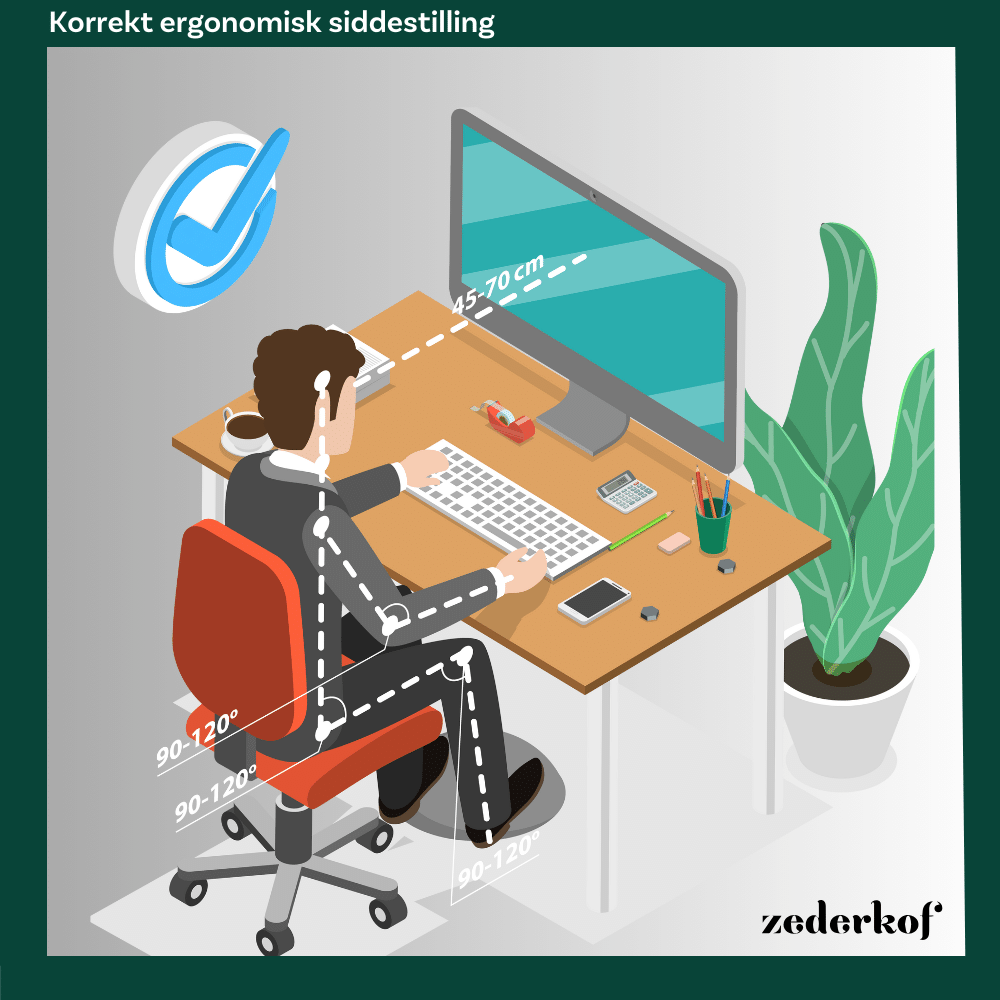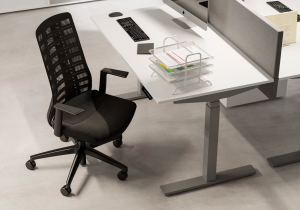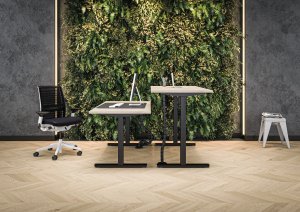How high should a desk be? This is how you find the right desk height

A desk is often the center of our workday. Whether you work from home or in the office, it is important to have a desk height that suits you. An incorrect height can lead to discomfort, fatigue, and even injuries in the long run.
So how do you find the right desk height? And what else should you consider to ensure a comfortable working position?
Comfort and productivity in the workplace with the right height of the desk
Having an ergonomically correct workstation is crucial for your comfort and productivity, especially if you spend many hours in front of a computer. One of the most important elements of an ergonomically correct workstation is the desk height.
But how high should a desk actually be? We will now go through this, so you know how to find the right height for the desk to ensure a comfortable working experience.
The height of the desk can make a big difference.
Finding the right desk height can make a big difference in your daily work. Remember to listen to your body and make adjustments as needed to achieve the most comfortable working position. This way, you can minimize the risk of discomfort and injuries while working more productively and healthily.
Standard desk height
There is not a one-size-fits-all desk height, as it depends on your height and personal preferences. The typical height of desks ranges between 72 and 74 cm. This suits most adults who are between 180 and 185 cm tall.
If you are taller or shorter than this, a fixed desk is likely not going to fit you very well – and then a height-adjustable desk a really good solution. A desk with adjustable height allows you to customize it to your individual preferences as well as vary your working position more throughout the day – for example, you can switch between sitting and standing work.


Switching between standing and sitting working positions can help provide:
- increased concentration among employees
- increased muscle activity and blood circulation
- increased fat burning among employees
- fewer pains in the back, shoulders, neck, and lower back
Source: https://www.hk.dk/omhk/sektor/stat/hk-statbladet/temaer/nedslidning
The result is:
- Increased satisfaction and well-being among the employees
- Better overall health for the employees
- Increased effort and energy among employees
How high should a desk be?
As mentioned, there is not one desk height that fits all – the ideal height of the desk depends on your height and personal preferences. Finding the right desk height is an individual process, and it is important to experiment to find the most comfortable position for you.
In short: The desk height should match your elbows when you are sitting. If you do not have an adjustable desk, a height-adjustable desk chair may be a solution. Remember that it is important to listen to your body. If you experience pain or discomfort, you should adjust your workstation until you find the right desk height that suits you.
Here are some guidelines you can use to determine the ideal desk height:
- Your height
- The distance from your elbows to the floor when you are sitting correctly
- Your elbows should be bent at an angle of about 90 degrees when your arms rest on the desk.
Find your ideal desk height
How to adjust the height of your desk – 5 easy steps
Finding the right desk height is crucial for your comfort and productivity. Here are some steps you can follow to correctly adjust the height of your desk:
1. Look down
When you are sitting at your desk, your screen should be at eye level or slightly below. This helps to avoid neck tension and pain.
2. Down with the shoulders
Your shoulders should be relaxed, not raised or tense. Adjust the desk so your arms rest comfortably on the surface, and your forearms are parallel to the floor.
3. Have plenty of space
Your desk should provide you with enough space to work without crowding. It should accommodate your computer, writing supplies, and other essentials without feeling cluttered.
4. Do not stand and hang
If you have a height-adjustable desk, it is good to vary your working position. But make sure that your desk height is also correct when you stand, so you do not strain your back or neck.
5. Change position throughout the day
It is important to move and change your working position from time to time. This can help reduce strain and improve blood circulation.
Achieve the right seating position – 4 tips for better well-being
To achieve the optimal working position, it is crucial to sit correctly at your desk. By following these simple guidelines for sitting posture and office furnishing you can minimize the risk of discomfort and pain associated with prolonged desk work. It is about creating a healthy and pleasant work experience that promotes productivity and well-being.
1. Sit properly – This is how you should sit at the desk
When you are sitting in your chair, both feet should rest flat on the floor or securely on a stool or similar. Keep your elbows close to your body and your forearms horizontal. The ideal is to have a hand’s width distance between the back of your knees and the edge of the chair seat, and the angle of your legs when bent should be greater than 90 degrees.
2. Adjust your screen correctly
Your screen should be positioned so that you naturally look slightly downward, just like when you read a book. The distance of the screen should be about an arm’s length away, and for larger screens, it can be a bit further. If possible, your screen should also avoid being placed with direct light behind or in front, as this can cause annoying reflections and too much contrast, which strains the eyes.
3. Find the right desk height
Your desk should have the option to be adjusted in height to fit your body. The tabletop should have sufficient depth so you can rest your forearms on the tabletop in front of the keyboard. The desk should be at a height where your shoulders are not held up but can hang relaxed when you are sitting at your desk.
If your desk is too high, it can push your shoulders upward and increase the risk of neck pain and headaches. Conversely, if it is too low, you may end up hunching your back and exposing yourself to back and neck pain.
4. Create space for work
On your desk, there should be enough space to organize your papers, place your mouse, and have room for other necessary work tools. A well-organized workstation makes it easier to maintain an efficient work rhythm.
Source: https://samvirke.dk/artikler/saadan-skal-du-sidde-ved-skrivebordet

Don’t forget the office chair
Your office chair also plays an important role in your working position. Choose an adjustable height chair that can be set in relation to your desk. Ensure that your back is supported and that you sit upright. Use an office chair with good lumbar support to achieve a correct sitting position. Remember that the most important thing is to achieve a comfortable working position that suits you.
You need this much legroom.
Last but not least, make sure there is enough space around and legroom under your desk so you can sit comfortably. This contributes to a more pleasant work experience.
More tips for the desk
In addition to finding the right desk height, there are other factors that can improve your workstation. Consider lighting, the size of the desk, as well as organizing cables and other items to keep your workspace tidy and efficient.
The height of the desk is crucial for your comfort and health.
Finding the right desk height is crucial for your comfort and health when working at a desk. Remember to follow the basic ergonomic guidelines and experiment with different settings until you find the best position for you. Your body will thank you for it with increased comfort and productivity at work.
Contact Zederkof for good advice on purchasing desks
We hope that this blog post helps you find the perfect height for your desk and achieve a more comfortable working position. If you have any questions, feel free to contact us; we are ready with advice and guidance. Send an email to info@zederkof.com or call us at tel. 89 12 12 00, so we can help you find the perfect desk or other office furniture to you.